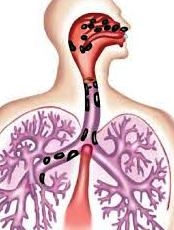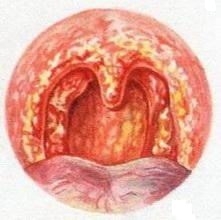There are endemic diseases that are common among a specific population that shares a common activity or living condition. Thus, scleroma disease is common among agricultural workers. Scleroma is more common in women and manifests itself at a young age, up to 20 years. What is scleroma, what are the causes and symptoms of its development, read on estet-portal.com.
What are the reasons for the formation of scleroma? Mechanism of development of scleroma
Scleroma is a disease of an infectious nature, the causative agent of which is the Frisch-Volkovich wand. The source of the disease is the person himself. The mechanism of transmission of the pathogen from person to person has not yet been fully elucidated. A contact route of transmission is assumed, however, not all people who have been in contact with the patient develop scleroma.
Scleroma develops slowly and lasts for many years. When ingested, the Frisch-Volkovich stick stays in the incubation period for a long time. The rod is located in a capsule, which greatly complicates the process of phagocytosis by macrophages. As a result, specific Mikulich cells are formed, which have foamy protoplasm and large sizes.
Later, the active phase of the inflammatory process begins, which is accompanied by the formation of granulomas. Granulomas in scleroma can have both endophytic and exophytic growth. With exophytic growth, scleroma can block the lumen of the respiratory tract, endophytic growth can move to the skin of the nose, deforming it. Bone structures are not affected by scleroma.
Then, the period of granuloma formation passes into the stage of scarring. This is characterized by the presence of cicatricial stenosis of the respiratory tract. The transition of the granuloma to the stage of scarring without the presence of ulcers is a distinctive feature of the scleroma.
What are scleromas? Classification of scleromas
Scleroma can affect the nasal cavity, pharynx, larynx, trachea and bronchi with its granulations. In rare cases, the conjunctiva, sinuses, oral cavity, outer and middle ear may be affected. During the course of the disease, 3 stages are distinguished: initial, active and cicatricial, or regressive.
According to the type of pathological process, scleroma can be productive, dystrophic or mixed. The dystrophic form is characterized by atrophic processes in the mucous membrane with the formation of a very viscous secret, which dries up with the formation of crusts. The productive form is characterized by the formation of infiltrates and granulomas.
What symptoms of granuloma development are important to identify at an early stage?
 Clinical manifestations of the disease begin to be noticeable several years after infection with the Frische-Volkovich bacillus. The initial period of granuloma formation in scleroma is characterized by the constant presence of non-specific symptoms: increased fatigue, weakness, headache, loss of appetite, drowsiness, malaise, decreased blood pressure, muscle hypotension. However, there are no local symptoms. The reason for going to the doctor is the long and persistent nature of the general symptoms. This is also the reason for a bacteriological study to identify the Frisch-Volkovich bacillus.
Clinical manifestations of the disease begin to be noticeable several years after infection with the Frische-Volkovich bacillus. The initial period of granuloma formation in scleroma is characterized by the constant presence of non-specific symptoms: increased fatigue, weakness, headache, loss of appetite, drowsiness, malaise, decreased blood pressure, muscle hypotension. However, there are no local symptoms. The reason for going to the doctor is the long and persistent nature of the general symptoms. This is also the reason for a bacteriological study to identify the Frisch-Volkovich bacillus.
In an active process, clinical symptoms appear against the background of local changes. Symptoms depend on the location, shape and nature of the scleroma. The extent of granuloma damage can vary from small single granulomas to large tumor-like formations. With scleroma, there is some feature of the formation of granulomas integrity & nbsp; the mucous membrane is not broken and synechia is not formed at the points of contact of opposite walls.
Symptoms of the presence of granuloma in scleroma, depending on its location
Most often, granulomas in the development of scleroma are localized in the nasal cavity. In the initial stages of the disease, scleroma is manifested by ordinary and banal rhinitis. The dystrophic form of scleroma is characterized by the presence of patient complaints about dryness of the nasal mucosa, the formation of crusts with an unpleasant odor, and a deterioration in the sense of smell. The productive form disrupts nasal breathing to varying degrees. In the presence of a granuloma in the pharynx, this is manifested by dryness, & nbsp; perspiration, discomfort in the throat, violation of the swallowing process. If the process takes place in the larynx, this is manifested by hoarseness of the voice.
 When the granuloma is located in the scleroma in the posterior sections of the nasal cavity, the scarring stage may end with choanal atresia. In the same patient, scleroma can affect different parts of the respiratory tract. Against the background of the development of scleroma, secondary infections can join with the development of pharyngitis, bronchitis, otitis and sinusitis. Long-existing scleroma can provoke the development of COPD, pneumosclerosis, emphysema, and bronchiectasis.
When the granuloma is located in the scleroma in the posterior sections of the nasal cavity, the scarring stage may end with choanal atresia. In the same patient, scleroma can affect different parts of the respiratory tract. Against the background of the development of scleroma, secondary infections can join with the development of pharyngitis, bronchitis, otitis and sinusitis. Long-existing scleroma can provoke the development of COPD, pneumosclerosis, emphysema, and bronchiectasis.
Thus, in the presence of non-specific symptoms that bother the patient for a long time, there is no need to postpone a visit to the doctor. Early detection of any pathology will only benefit.







Add a comment